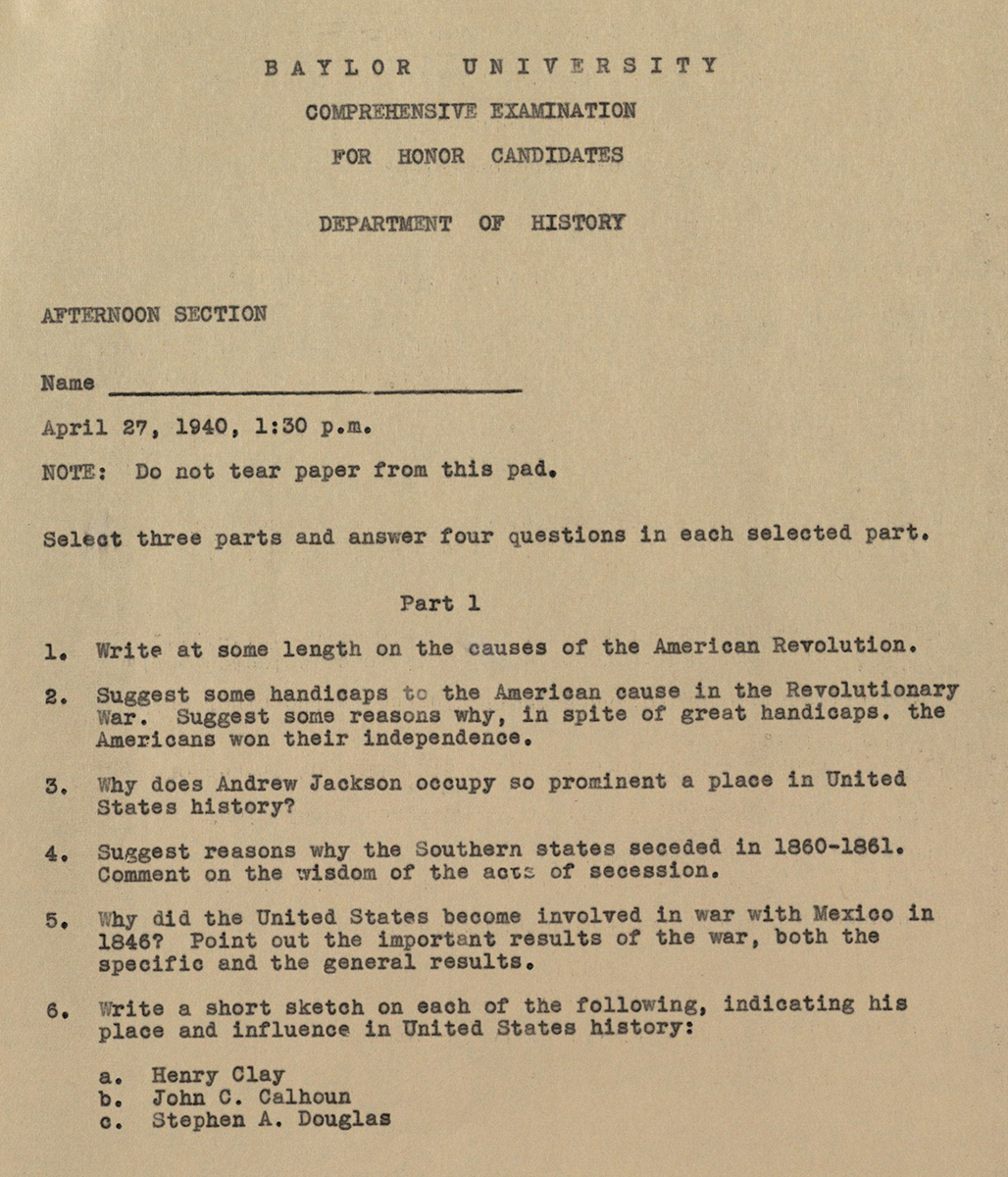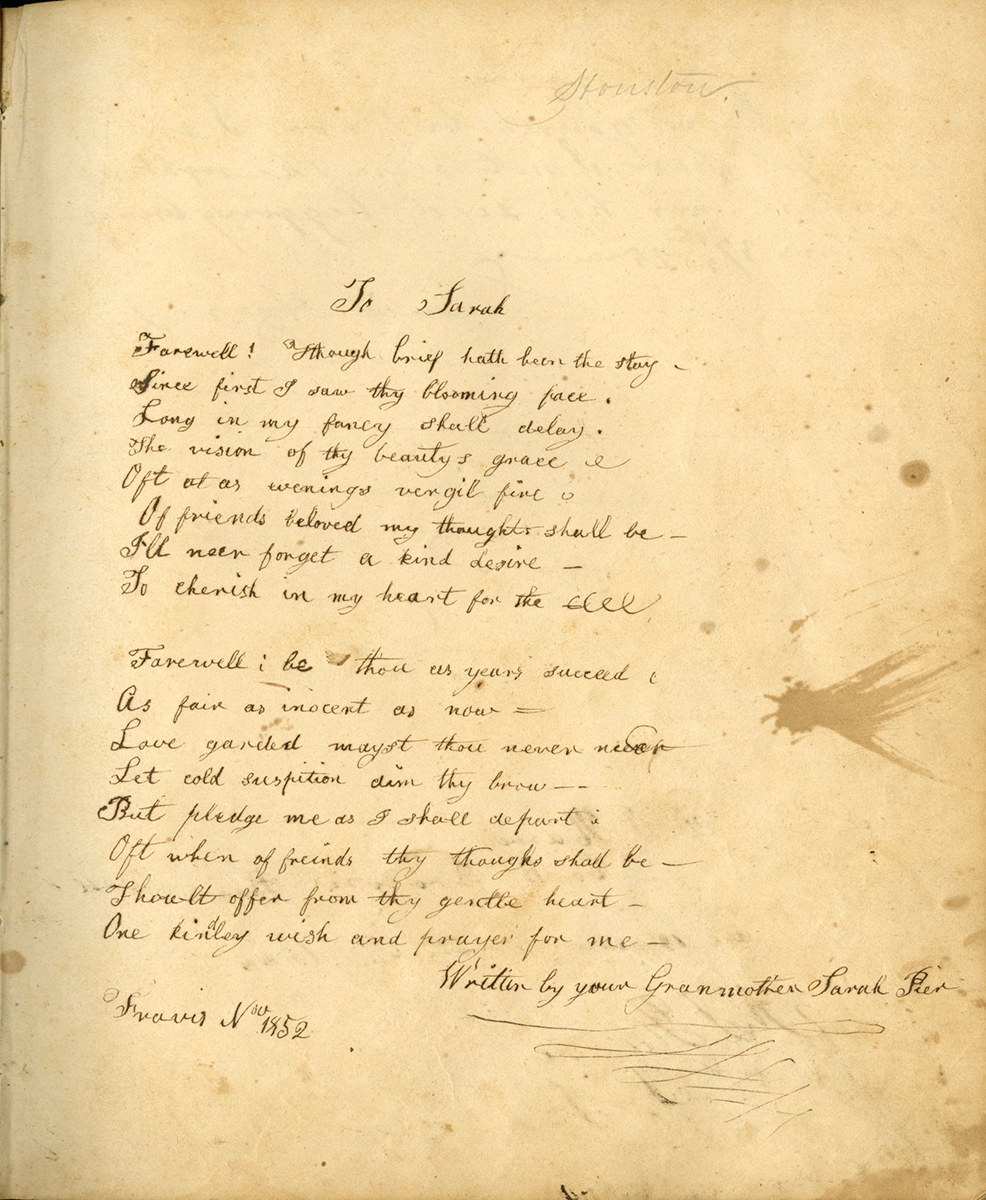For the past two weeks, we’ve been writing about the Parker family—see Part 1 and Part 2. Last week’s post was about the preservation of Old Fort Parker. Today we continue the story with the Parker family’s work to preserve its historical documents—what is now the Jack and Gloria Parker Selden collection, housed at The Texas Collection.
The story of preserving Parker family materials through time is impressive in its own right. With many documents in the collection dating back to the 19th century, it is remarkable that so many of these papers survived. Family historians faithfully stored and studied the documents and made sure the materials endured for the next generation of the family. Now, by giving them to The Texas Collection, these documents are preserved and accessible for the public to view and research.
Materials in this collection were assembled, collected, and preserved by three distinct groups in the Parker family: Joseph and Araminta Taulman, Lee Parker Boone, and Jack Selden, though many other Parker family members contributed to the preservation of their family history, including Joe Bailey Parker and Ben J. Parker. Each of the three major preservation groups represents a different generation in the Parker family history, and each contributed different research materials and collecting emphasis to the collection.

It seems that family members began gathering historical documents relating to family history very early in their time in Texas. By 1854, the materials were stored in a container the family has referred to as the “blue box” by Dan Parker, grandson of Daniel Parker. This box of documents was added to over time and passed down through the family. It eventually came to Jack Selden and contained most of what is now Series I, the oldest materials in the collection.
Joseph and Araminta Taulman were active in Texas public history in the 1930s. Araminta was the great-great-granddaughter of Daniel Parker, patriarch of the Parker family in the 1830s. While the Taulmans created some materials now in the Jack and Gloria Parker Selden collection, most of the Taulman papers are now in the Joseph E. Taulman Collection at the Briscoe Center for American History at The University of Texas at Austin.

Lee Parker Boone, born in 1891, focused on collecting and describing Parker genealogy information for much of his life. Boone was a court reporter in Midland, Texas. In the Selden collection, many of the letters inquiring about family trees and giving information about possible family relationships were from or to Boone.
Jack Selden was born in 1929 and graduated from Palestine High School in Texas. After graduating from George Washington University, he served in the United States Air Force as a navigator and speechwriter for 21 years, eventually becoming a lieutenant colonel. Returning to Palestine, he became a civil trial assistant. In 1985, he became mayor of Palestine, serving three terms.

At some point, Selden became the historian of the Parker family and faithfully preserved an increasingly large collection of documents, photographs, and other materials containing his research on the topic, plus the work of Lee Boone, selections from Joseph Taulman, and others who contributed to preserving the Parker family story. With these resources, Selden wrote and published a book on the Parker family in Texas history. Return: The Parker Story, published in 2006, documents the Parker family’s arrival in Texas, and traces their history through Cynthia Ann Parker, Quanah Parker, and others, up to the Parker family reunions today. This past year, Selden donated this collection of materials to The Texas Collection.
Jack Selden also wrote and performed in the “Telling of the Tales,” a dramatic reading of the Cynthia Ann Parker story. Other Parker family members also participated in the production. This drama was performed several times for the public, both at Old Fort Parker in the early 1980s and at Pilgrim Baptist Church near Elkhart, Texas. Programs and scripts from “Telling of the Tales” performances can be found in the Selden collection.
This concludes our series celebrating the Jack and Gloria Parker Selden papers arrival at The Texas Collection. Mark your calendar for Selden’s lecture: Thursday, February 18, at 3:30 pm in the Guy B. Harrison Reading Room of The Texas Collection, located in Carroll Library at Baylor University. If you can’t make the lecture, follow us on Twitter—we’ll be live-tweeting the event at #ParkerFamilyTX.
Sources:
Find a Grave, Inc. “Lee Parker Boone.” Memorial #22788886. Databases. Accessed February 8, 2016.
Joseph E. Taulman Collection, 1783-1994, Dolph Briscoe Center for American History, University of Texas at Austin.
Selden, Jack. Return: the Parker Story. Palestine: Clacton Press, 2006.













